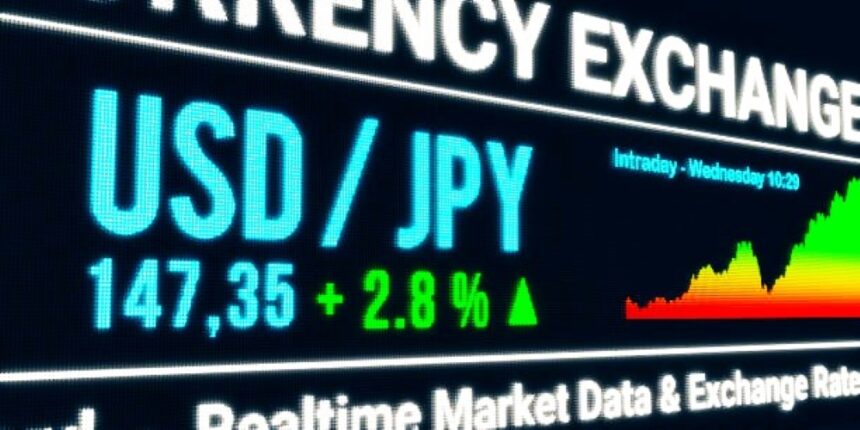Japanese Yen Gains Momentum for Fourth Consecutive Session
The Japanese Yen (JPY) surged for the fourth day in a row on Friday, marking a notable streak of strength against the US Dollar (USD). In early Asian trading, the Yen hit its strongest level of the week, breaking below the 145.00 threshold in the USDJPY pair. Despite a disappointing Q1 GDP release from Japan, the Yen remained resilient, supported by rising speculation that the Bank of Japan (BoJ) will pursue another interest rate hike this year.
This firming of the Yen comes against a backdrop of diverging monetary policies between Japan and the United States. While the BoJ is shifting gradually toward normalization, the Federal Reserve (Fed) is leaning dovishly in the face of softening inflation and slowing consumer activity. This divergence has helped to cement the JPY’s bullish bias, driving renewed interest in the safe-haven currency.
BoJ Hawkish Signals Outweigh Japan’s Economic Contraction
Japan’s economic outlook took a hit Friday when the preliminary GDP reading for Q1 2025 showed the economy contracted by 0.2%, missing the forecast of a 0.1% decline. On an annualized basis, GDP fell by 0.7%, the first negative print in a year. The data painted a worrisome picture, especially after the previous quarter’s 0.6% growth.
Ordinarily, such a contraction would weaken the local currency. However, the market appears more focused on the monetary policy trajectory. A hawkish tilt from the BoJ—underscored by recent central bank communications—is providing a solid cushion for the JPY.
The BoJ’s Summary of Opinions from its April 30–May 1 meeting revealed that several policymakers remain open to resuming rate hikes later in 2025. Deputy Governor Shinichi Uchida reaffirmed this stance earlier this week, signaling that the central bank is prepared to act if conditions justify it, particularly if U.S. trade policy stabilizes.
Market Sees Potential for Another BoJ Hike in 2025
A recent Reuters survey showed that while most economists expect the BoJ to keep interest rates on hold through September, a slim majority now believe the central bank will hike rates at least once by the end of 2025. Such a shift in expectations is significant in the context of Japan’s decades-long ultra-loose policy regime.
The BoJ’s pivot is viewed by analysts as an attempt to counteract imported inflation and currency depreciation. It’s also being interpreted as a strategic response to Japan’s prolonged exposure to external shocks, including U.S. tariff threats and global supply chain vulnerabilities.
In tandem, political momentum is also building. Japan’s top trade negotiator, Ryosei Akazawa, is reportedly preparing for another round of talks in Washington next week. Japan aims to extract U.S. tariff concessions, with Akazawa confirming that Tokyo will support impacted firms with liquidity measures. Finance Minister Shunichi Kato is expected to meet U.S. Treasury Secretary Scott Bessent soon to discuss foreign exchange matters—a key signal that Tokyo is actively managing Yen policy via diplomatic channels as well.
US Dollar Weakness Fuels Japanese yen Upside
While the Japanese Yen resilience is noteworthy, the backdrop of US Dollar weakness has made the move even more pronounced. The USD has come under renewed pressure amid signals that the Fed may be forced to cut rates multiple times over the coming quarters.
Data from the U.S. Bureau of Labor Statistics on Thursday showed that the Producer Price Index (PPI) fell 0.5% in April, the largest monthly decline in more than a year. On an annual basis, PPI rose 2.4%, while core PPI came in at 3.1%, down from 4.0% in March. These figures suggest a cooling in input prices, reinforcing the view that broader consumer inflation will continue to moderate.
Meanwhile, U.S. Retail Sales barely budged in April, up just 0.1%, sharply down from the upwardly revised 1.7% growth in March. Sluggish consumption trends, combined with falling inflation, point toward subdued economic momentum. This dovish macro backdrop has driven U.S. Treasury yields lower, weighing further on the USD and amplifying the downward drift in USD/JPY.
Fed’s Policy Path Supports Yen Strength
Market pricing now suggests a high likelihood of multiple Fed rate cuts by early 2026. Swaps and futures markets have nearly fully priced in two 25-basis-point rate reductions by year-end, with the first potentially arriving as soon as September.
Federal Reserve officials remain cautious, but the trend in macroeconomic data—particularly consumer demand and inflation—is leading investors to bet against any further tightening. If anything, the Fed may be preparing to pivot more decisively to a rate-cutting cycle, potentially widening the yield gap between U.S. and Japanese government bonds and giving JPY bulls more reason to stay engaged.
US-China Trade Thaw Adds Limited Pressure on Safe-Haven Japanese yen
Another factor influencing the Japanese yen is the broader risk sentiment. A breakthrough in U.S.-China trade talks this week brought some relief to equity markets, as both nations agreed to de-escalate tariff tensions for at least 90 days. President Donald Trump also expressed willingness to meet President Xi Jinping to hammer out a broader trade accord.
While this has generated modest risk-on flows in global markets, the impact on the JPY has been limited. In fact, the ongoing trade negotiations and their uncertain outcomes may reinforce the safe-haven appeal of the Yen, particularly if geopolitical uncertainty persists.
Technical Outlook: USD/JPY Eyes Next Support at 144.60
From a technical standpoint, the USD/JPY pair has breached key support levels, falling below 145.00—a psychologically important threshold. The next immediate support lies near 144.60, followed by 144.00. On the upside, resistance is seen around 145.70 and 146.30.
Momentum indicators suggest further downside could be in the cards, especially if bond yields in the U.S. continue to slide. A deeper correction may open the door to a retest of April lows near 143.50.
Outlook: BoJ Policy in the Driver’s Seat
The USD/JPY outlook will remain tethered to central bank narratives in the near term. The Fed’s dovish pivot is nearly priced in, while BoJ rate hike bets are just gaining traction. This asymmetry is likely to keep the JPY supported in the coming weeks—especially if Japan avoids further economic deterioration.
All eyes will now turn to next week’s potential trade developments between Japan and the U.S., as well as upcoming U.S. inflation and jobs data, which could influence Fed rate expectations further. For now, the Yen remains the favored currency among G10 majors.
[faq-schema id=”39596″]









